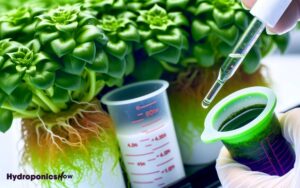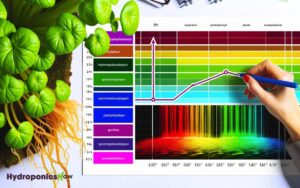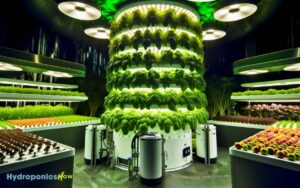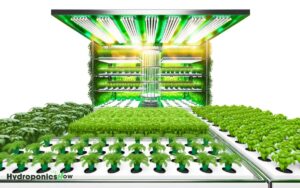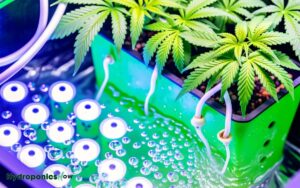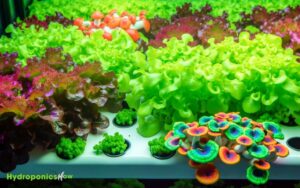Hydroponics for Beginners: Yes Plant Garlic
Yes, you can plant garlic in hydroponics. Hydroponic garlic enjoys optimized nutrient delivery, efficient water usage, and year-round production.
Select suitable varieties like Softneck or Hardneck. Prepare a balanced nutrient solution and monitor pH levels for ideal uptake.
Provide full-spectrum LED lights and maintain temperatures between 60-70°F. Use a hydroponic setup that guarantees proper root support and spacing.
Regularly check for signs of pests and diseases as early intervention is essential. Adhering to these guidelines will promote robust garlic growth, leading to a successful harvest. If you’re interested, further details can help refine your hydroponic garlic cultivation.
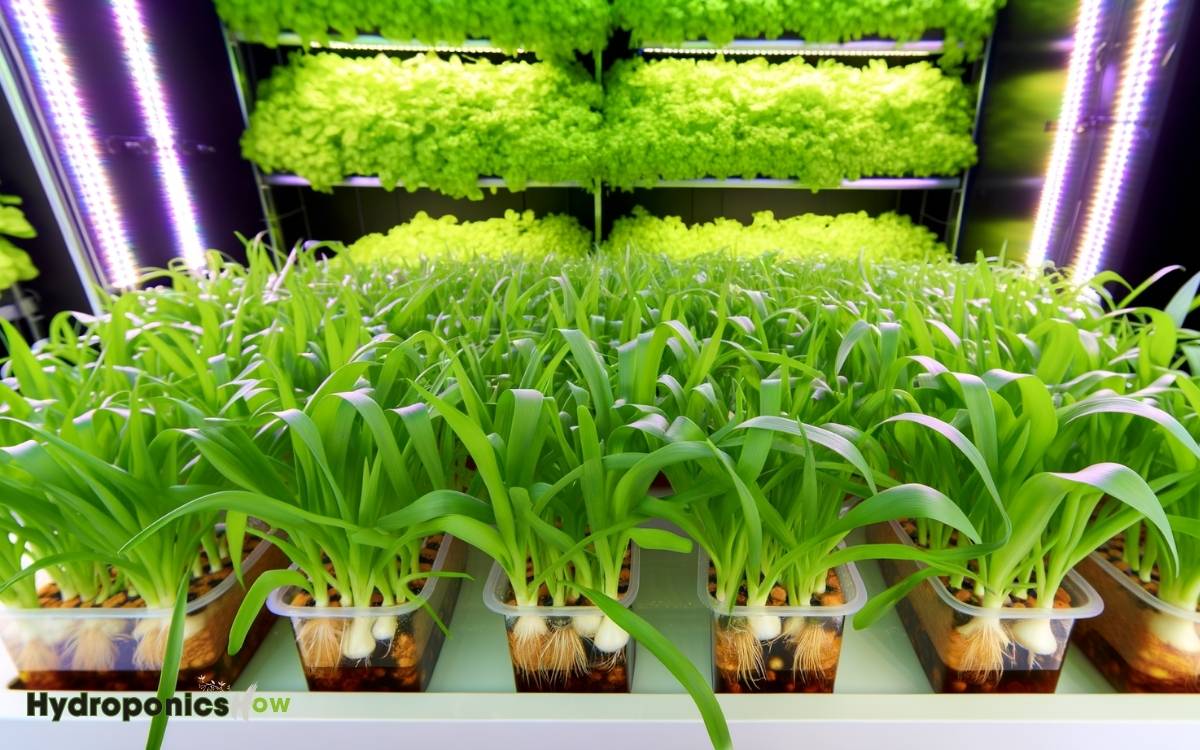
Key Takeaways
Benefits of Hydroponic Garlic
Hydroponic garlic cultivation offers several advantages, including optimized nutrient delivery, efficient water usage, and the potential for year-round production.
By directly supplying essential nutrients through a carefully monitored solution, hydroponics guarantees that garlic plants receive the precise balance required for ideal growth. This method minimizes nutrient wastage and enhances plant health. Additionally, this approach allows growers to fine-tune nutrient levels, ensuring optimal development at every stage of growth. Using products like Miracle Gro Plant Food Hydroponics can further enhance nutrient delivery, providing garlic plants with the essential minerals they need. As a result, hydroponic garlic cultivation becomes more efficient, yielding healthier plants and higher-quality harvests.
Additionally, hydroponic systems use considerably less water compared to traditional soil-based farming, as water is recirculated within the system, reducing overall consumption.
The controlled environment of hydroponic setups also mitigates the impact of seasonal variations, allowing for continuous garlic production irrespective of external weather conditions.
These benefits collectively make hydroponic garlic cultivation a sustainable and efficient alternative to conventional agricultural practices.
Choosing the Right Garlic Varieties
Selecting the appropriate garlic varieties for hydroponic cultivation is essential, as different types can exhibit varying growth characteristics, nutrient requirements, and resistance to diseases.
To optimize your hydroponic system, consider the following garlic varieties:
| Variety | Growth Characteristics | Disease Resistance |
|---|---|---|
| Softneck | Compact growth, high yield | Moderate resistance |
| Hardneck | Sturdy stalks, larger cloves | High resistance to cold |
| Elephant | Larger bulbs, slower growth | Low resistance |
| Creole | Tolerates heat, spicy flavor | Moderate resistance |
| Asiatic | Early maturing, small bulbs | High disease resistance |
Softneck and Hardneck varieties are generally recommended due to their adaptability and robust performance in controlled environments. Evaluate specific needs and environmental constraints carefully to select the most suitable variety for your hydroponic setup.
Setting Up Your Hydroponic System
Setting up your hydroponic system for garlic cultivation begins with selecting the appropriate equipment. This includes grow lights, reservoirs, and aeration devices to guarantee ideal growth conditions.
Equally important is the preparation of a balanced nutrient solution tailored to the specific needs of garlic plants. This solution should encompass essential macro and micronutrients.
Proper calibration and maintenance of both the equipment and nutrient solution will be critical to achieving high yields and healthy plants.
Choosing the Right Equipment
To successfully cultivate garlic hydroponically, it is crucial to meticulously select and assemble the appropriate equipment for your system.
Begin with a suitable hydroponic setup, such as Deep Water Culture (DWC) or Nutrient Film Technique (NFT), which offer ideal root oxygenation and nutrient delivery.
Make sure your grow medium, like coconut coir or rock wool, supports garlic root structure. High-quality grow lights, preferably LED, are essential to simulate sunlight, ensuring vigorous growth.
Incorporate an efficient water pump and air stones to maintain nutrient circulation and oxygenation.
Use pH and EC meters to monitor water quality consistently. Finally, invest in a reliable timer system to automate lighting and watering schedules, maintaining consistency in your garlic’s growth conditions.
Nutrient Solution Preparation
After assembling your hydroponic setup with the appropriate equipment, the next step involves formulating a balanced nutrient solution tailored to garlic’s specific growth requirements.
Garlic thrives in a nutrient solution with a pH range of 6.0 to 6.5 and an electrical conductivity (EC) of 1.4 to 2.0 mS/cm.
Essential macronutrients include nitrogen (N), phosphorus (P), and potassium (K) in a ratio of approximately 10-8-12.
Additionally, trace elements like magnesium (Mg), calcium (Ca), iron (Fe), and zinc (Zn) are vital. Dissolve these nutrients in dechlorinated water, ensuring thorough mixing.
Regularly monitor and adjust the pH and EC to maintain ideal conditions. Proper nutrient management ensures robust growth and maximizes your garlic yield.
Nutrient Requirements for Garlic
Garlic’s nutrient requirements in a hydroponic system are essential for maximum growth and bulb development, necessitating a balanced supply of macro and micronutrients tailored to its specific needs.
Key macronutrients include nitrogen (N), phosphorus (P), and potassium (K). Nitrogen is vital for leaf growth, while phosphorus supports root and bulb formation, and potassium enhances overall plant vigor.
Micronutrients such as calcium, magnesium, and sulfur are also crucial; calcium strengthens cell walls, magnesium is a central component of chlorophyll, and sulfur aids in amino acid synthesis.
Regular monitoring and adjustment of nutrient concentrations in the solution guarantee optimal uptake. pH levels should be maintained between 6.0 and 6.5 to facilitate efficient nutrient absorption and prevent deficiencies.
Planting Garlic Cloves
Initiating garlic cultivation in a hydroponic system demands meticulous selection and preparation of high-quality garlic cloves to guarantee robust growth and development.
| Step | Action | Purpose |
|---|---|---|
| 1 | Select large cloves | Ensure healthy plants |
| 2 | Soak in water | Stimulate root growth |
| 3 | Plant 2′ apart | Optimize space and growth |
This methodical approach fosters a conducive environment for garlic to thrive in hydroponic systems.
Managing Light and Temperature
Proper management of light and temperature is crucial in guaranteeing ideal growth and maximizing the yield of garlic in a hydroponic system.
Garlic requires approximately 12-16 hours of light daily, preferably from full-spectrum LED lights, to mimic natural sunlight. Maintain a consistent light schedule to avoid stress on the plants.
Temperature control is equally vital; peak growth occurs between 60-70°F (15-21°C). Night temperatures should not drop below 55°F (13°C) to prevent stunted growth. Utilize thermostats and fans for precise temperature regulation.
Additionally, ensure adequate air circulation to prevent mold and mildew, which can thrive in humid environments. Implementing these measures will create a controlled environment conducive to robust garlic growth in hydroponic setups.
Common Issues and Solutions
Despite meticulous management of light and temperature, growers may still encounter several common issues in hydroponic garlic cultivation that require proactive solutions to maintain peak plant health and yield.
Root rot, often caused by Pythium species, can be mitigated through diligent monitoring of nutrient solution temperatures, making sure they remain between 18-22°C, and maintaining proper aeration.
Additionally, nutrient imbalances, such as nitrogen toxicity or deficiencies in potassium and phosphorus, necessitate regular monitoring and adjustment of the nutrient solution’s composition.
Pest infestations, particularly aphids and spider mites, can be controlled using integrated pest management strategies, including biological controls like predatory insects.
Harvesting and Storing Garlic
Harvesting garlic in a hydroponic system demands careful attention to the maturity indicators, such as yellowing and browning of the lower leaves, to guarantee excellent flavor and storage longevity.
Once these signs are apparent, cease watering for a few days to allow the bulbs to harden. Gently remove the bulbs from the system, ensuring minimal root disturbance.
Post-harvest, cure the garlic by hanging it in a well-ventilated area with a temperature of around 15-20°C and low humidity for two weeks. This process is essential for reducing moisture content and enhancing storage life.
Store the cured garlic in a cool, dry place with good air circulation to prevent mold and extend usability for several months.
Conclusion
In the domain of hydroponic cultivation, growing garlic can be likened to a carefully choreographed ballet, where each element—from nutrient solutions to light conditions—plays an essential role in the performance.
By selecting appropriate garlic varieties and meticulously managing environmental factors, one can achieve a successful harvest.
The journey, though intricate, yields rewards akin to a well-executed dance, showcasing the harmony between nature and technology in the pursuit of agricultural excellence.

